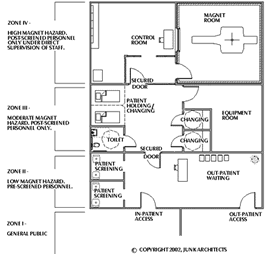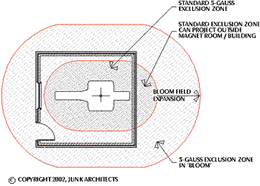
 Increase
in use of Magnetic Resonance Imaging (MRI) scanners for medical diagnosis
in hospitals, clinics, and freestanding facilities prompts consideration
of special structural and safety basics for this unique equipment. In
a Special Report for DiagnosticImaging.com, Robert Paul Junk, AIA, and
Tobias Gilk, Junk Architects, Kansas City, Mo., outline spatial considerations
for safe use of MRI scanners.
Increase
in use of Magnetic Resonance Imaging (MRI) scanners for medical diagnosis
in hospitals, clinics, and freestanding facilities prompts consideration
of special structural and safety basics for this unique equipment. In
a Special Report for DiagnosticImaging.com, Robert Paul Junk, AIA, and
Tobias Gilk, Junk Architects, Kansas City, Mo., outline spatial considerations
for safe use of MRI scanners.
Patients and personnel must be protected from the strong magnetic field that surrounds magnetic resonance imaging (MRI) scanners. The magnet that is the core of the MRI scanner can cause severe injury, massive property damage, and even death to persons with pacemakers, ferrous implants, or carrying loose objects containing iron. In planning an MR suite, the magnet becomes a central design consideration.
 The
standard exclusion zone around the magnet includes all areas where the
magnetic field is five gauss or more. This minimum exclusion zone extends
in all directions around the magnet, including above and below, and may
extend above ceilings and roof, below floors, and outside the building.
Magnetic shielding of this zone includes use of tons of steel plating,
which affect structural considerations beyond the tremendous weight of
the magnet itself.
The
standard exclusion zone around the magnet includes all areas where the
magnetic field is five gauss or more. This minimum exclusion zone extends
in all directions around the magnet, including above and below, and may
extend above ceilings and roof, below floors, and outside the building.
Magnetic shielding of this zone includes use of tons of steel plating,
which affect structural considerations beyond the tremendous weight of
the magnet itself.
Considerations related to the five-gauss exclusion zone may also include the design for and access to adjacent spaces. Obviously adjacencies to cardiac facilities require attention. Operational considerations are also in order.
 Operational
considerations
Operational
considerations
• It is crucial for MR staff to have direct visual supervision of
all persons within the MR suite at all times. At the same time, bringing
patients through staffed positions, such as the MR control room, introduces
the possibility of confidentiality conflicts for other patients.
• Zoning that allows controlled in-patient ingress and out-patient
egress, waiting areas, patient screening, patient changing/holding areas,
and the MR room itself may mean staged areas. (See diagram.)
• Providing adequate seating and bathrooms in the various staging
areas facilitates the comfortable accommodation of patients when this
very expensive equipment is used to maximum capacity.
• Computers and other sensitive equipment may need further protection
beyond the five-gauss exclusion zone.
• Installation of MR equipment is very expensive. It may be wise
to consider expansion for subsequent MR suites when designing for the
first to minimize those first-cost installation expenses, especially when
you consider the lost-revenue cost of having to shut down the operating
MR during installation of additional units.
• Design solutions alone cannot ensure facility safety, but they
can dramatically affect the implementation of safety protocols and long-range
operations.
Copyright 2003 The American Institute of Architects. All rights reserved.
![]()
| Read the full report by Robert Paul Junk, AIA, and Tobias Gilk. For more information on MR safety, visit the Diagnostic Imaging and American College of Radiology sites. For articles on MR safety and MR accidents, see the following Web sites: re: flying objects from the FDA from WebMD. |
|